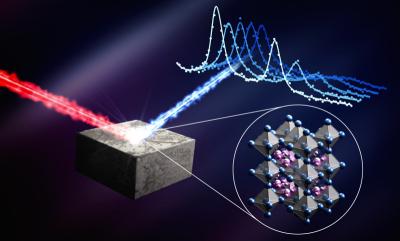An international team of researchers led by the U.S. Department of Energy's SLAC National Accelerator Laboratory (that also included, among others, researchers from NIST, the University of Bath, Kings College London and Yonsei University) has gained new understanding of the movement of atoms in perovskite materials and how it affects the functioning of those materials. The results could explain why perovskite solar cells are so efficient and aid the quest to design hot-carrier solar cells, a theorized technology that would almost double the efficiency limits of conventional solar cells by converting more sunlight into usable electrical energy.

Common materials that make up conventional solar cells display a nearly rigid arrangement of atoms with little movement. In hybrid perovskites, however, the arrangements are more flexible and atoms move around more freely, an effect that impacts the performance of the solar cells but has been difficult to measure.
In this study, theorists working as part of the team provided a theoretical framework for interpreting experimental results, which predicted that acoustic phonons traveling through perovskites would have short lifetimes as a result of the flexible arrangements of dancing atoms (atoms moving rather freely around) and molecules in the material.
Stanford chemists Hema Karunadasa and Ian Smith were able to grow the large, specialized single crystals that were essential for this work. With the help of Peter Gehring, a physicist at the NIST Center for Neutron Research, the team scattered neutrons off these perovskite single crystals in a way that allowed them to retrace the motion of the atoms and molecules within the material. This allowed them to precisely measure the lifetime of the acoustic phonons.
The research team found that in perovskites, acoustic phonons are incredibly short-lived, surviving for only 10 to 20 trillionths of a second. Without these phonons moving heat through the material, the electrons might stay hot and hold onto their energy as they're pulled out of the material. Harnessing this effect could potentially lead to hot-carrier solar cells with efficiencies that are nearly twice as high as conventional solar cells.
In addition, this phenomenon could explain how perovskite solar cells work so well despite the material being riddled with defects that would trap electrons and dampen performance in other materials.
"Since phonons in perovskites don't travel very far, they end up heating the area surrounding the electrons, which might provide the boost the electrons need to escape the traps and continue on their merry way," the team says.
To follow up on this study, researchers at the Center for Hybrid Organic-Inorganic Semiconductors for Energy (CHOISE) Energy Frontier Research Center led by DOE's National Renewable Energy Laboratory will investigate this phenomenon in more complicated perovskite materials that are shown to be more efficient in energy devices. They would like to figure out how changing the chemical make-up of the material affects acoustic phonon lifetimes.
"We need to fundamentally transform our energy system as quickly as possible," says Aryeh Gold-Parker, who co-led the study as a Ph.D. student at Stanford University and SLAC. "As we move toward a low-carbon future, a very important piece is having cheap and efficient solar cells. The hope in perovskites is that they'll lead to commercial solar panels that are more efficient and cheaper than the ones on the market today."



